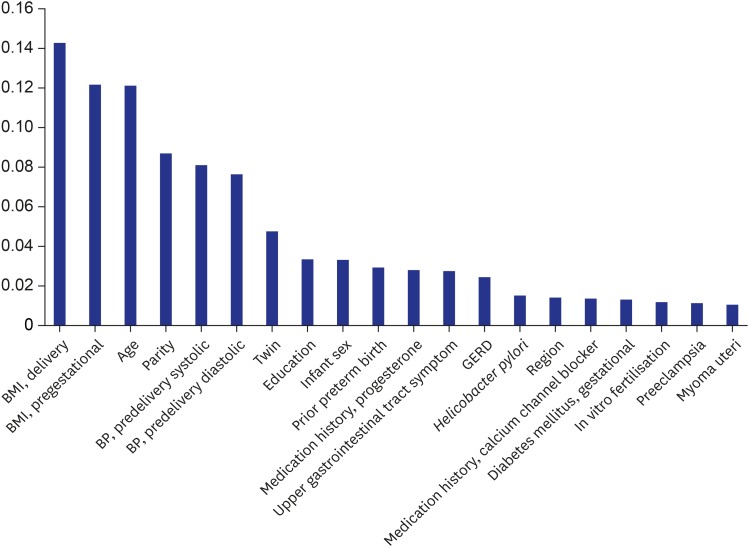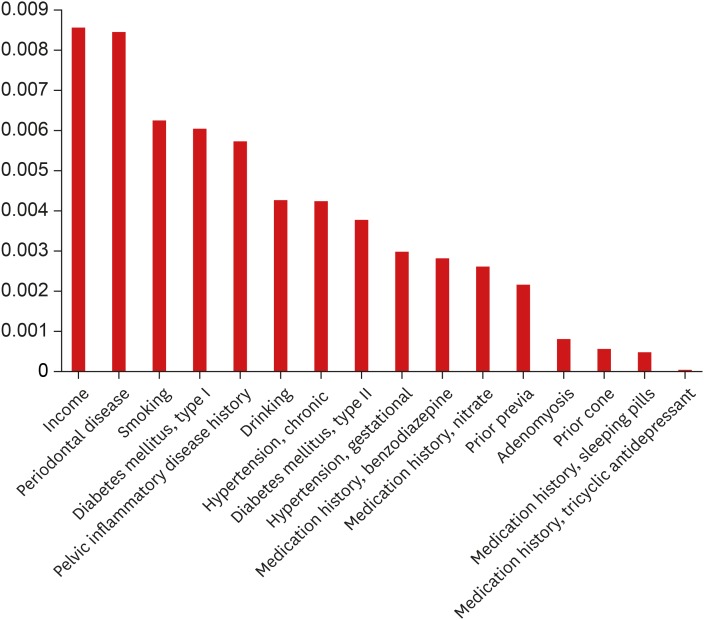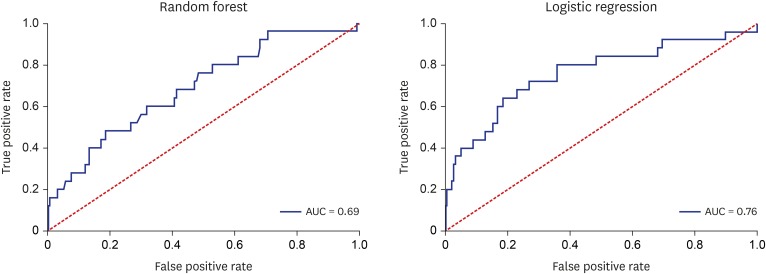J Korean Med Sci.
2020 Apr;35(14):e105. 10.3346/jkms.2020.35.e105.
Determinants of Spontaneous Preterm Labor and Birth Including Gastroesophageal Reflux Disease and Periodontitis
- Affiliations
-
- 1AI Center, Korea University Anam Hospital, Seoul, Korea.
- 2Department of Oral & Maxillofacial Surgery, Korea University Anam Hospital, Seoul, Korea.
- 3Department of Gastroenterology, Korea University Anam Hospital, Seoul, Korea.
- 4Department of Obstetrics & Gynecology, Korea University Anam Hospital, Seoul, Korea.
- KMID: 2509615
- DOI: http://doi.org/10.3346/jkms.2020.35.e105
Abstract
- Background
Periodontitis is reported to be associated with preterm birth (spontaneous preterm labor and birth). Gastroesophageal reflux disease (GERD) is common during pregnancy and is expected to be related to periodontitis. However, little research has been done on the association among preterm birth, GERD and periodontitis. This study uses popular machine learning methods for analyzing preterm birth, GERD and periodontitis.
Methods
Data came from Anam Hospital in Seoul, Korea, with 731 obstetric patients during January 5, 1995 - August 28, 2018. Six machine learning methods were applied and compared for the prediction of preterm birth. Variable importance, the effect of a variable on model performance, was used for identifying major determinants of preterm birth.
Results
In terms of accuracy, the random forest (0.8681) was similar with logistic regression (0.8736). Based on variable importance from the random forest, major determinants of preterm birth are delivery and pregestational body mass indexes (BMI) (0.1426 and 0.1215), age (0.1211), parity (0.0868), predelivery systolic and diastolic blood pressure (0.0809 and 0.0763), twin (0.0476), education (0.0332) as well as infant sex (0.0331), prior preterm birth (0.0290), progesterone medication history (0.0279), upper gastrointestinal tract symptom (0.0274), GERD (0.0242), Helicobacter pylori (0.0151), region (0.0139), calcium-channel-blocker medication history (0.0135) and gestational diabetes mellitus (0.0130). Periodontitis ranked 22nd (0.0084).
Conclusion
GERD is more important than periodontitis for predicting and preventing preterm birth. For preventing preterm birth, preventive measures for hypertension, GERD and diabetes mellitus would be needed alongside the promotion of effective BMI management and appropriate progesterone and calcium-channel-blocker medications.
Figure
Cited by 3 articles
-
Automatic Classification of the Korean Triage Acuity Scale in Simulated Emergency Rooms Using Speech Recognition and Natural Language Processing: a Proof of Concept Study
Dongkyun Kim, Jaehoon Oh, Heeju Im, Myeongseong Yoon, Jiwoo Park, Joohyun Lee
J Korean Med Sci. 2021;36(27):e175. doi: 10.3346/jkms.2021.36.e175.Association of Gastroesophageal Reflux Disease with Preterm Birth: Machine Learning Analysis
Kwang-Sig Lee, Eun Sun Kim, Do-young Kim, In-Seok Song, Ki Hoon Ahn
J Korean Med Sci. 2021;36(43):e282. doi: 10.3346/jkms.2021.36.e282.Artificial intelligence in obstetrics
Ki Hoon Ahn, Kwang-Sig Lee
Obstet Gynecol Sci. 2022;65(2):113-124. doi: 10.5468/ogs.21234.
Reference
-
1. Magro Malosso ER, Saccone G, Simonetti B, Squillante M, Berghella V. MagroMalosso ER. US trends in abortion and preterm birth. J Matern Fetal Neonatal Med. 2018; 31(18):2463–2467. PMID: 28629238.
Article2. Lee NH. International trends and implications for preterm birth. Health Soc Welf Forum. 2013; (200):116–127.3. World Health Organization. News: preterm birth. Updated 2018. Accessed June 1, 2019. http://www.who.int/news-room/fact-sheets/detail/preterm-birth.4. Harrison MS, Goldenberg RL. Global burden of prematurity. Semin Fetal Neonatal Med. 2016; 21(2):74–79. PMID: 26740166.
Article5. Eke PI, Dye BA, Wei L, Slade GD, Thornton-Evans GO, Borgnakke WS, et al. Update on prevalence of periodontitis in adults in the United States: NHANES 2009 to 2012. J Periodontol. 2015; 86(5):611–622. PMID: 25688694.
Article6. Puertas A, Magan-Fernandez A, Blanc V, Revelles L, O'Valle F, Pozo E, et al. Association of periodontitis with preterm birth and low birth weight: a comprehensive review. J Matern Fetal Neonatal Med. 2018; 31(5):597–602. PMID: 28282773.
Article7. Vakil N, van Zanten SV, Kahrilas P, Dent J, Jones R. Global Consensus Group. The Montreal definition and classification of gastroesophageal reflux disease: a global evidence-based consensus. Am J Gastroenterol. 2006; 101(8):1900–1920. PMID: 16928254.
Article8. Patrick L. Gastroesophageal reflux disease (GERD): a review of conventional and alternative treatments. Altern Med Rev. 2011; 16(2):116–133. PMID: 21649454.9. Vinesh E, Masthan K, Kumar MS, Jeyapriya SM, Babu A, Thinakaran M. A clinicopathologic study of oral changes in gastroesophageal reflux disease, gastritis, and ulcerative colitis. J Contemp Dent Pract. 2016; 17(11):943–947. PMID: 27965506.10. Deppe H, Mücke T, Wagenpfeil S, Kesting M, Rozej A, Bajbouj M, et al. Erosive esophageal reflux vs. non erosive esophageal reflux: oral findings in 71 patients. BMC Oral Health. 2015; 15(1):84. PMID: 26208714.
Article11. Ali RA, Egan LJ. Gastroesophageal reflux disease in pregnancy. Best Pract Res Clin Gastroenterol. 2007; 21(5):793–806. PMID: 17889808.
Article12. Lee KS, Ahn KH. Artificial neural network analysis of spontaneous preterm labor and birth and its major determinants. J Korean Med Sci. 2019; 34(16):e128. PMID: 31020816.
Article13. Kim YJ, Lee BE, Park HS, Kang JG, Kim JO, Ha EH. Risk factors for preterm birth in Korea: a multicenter prospective study. Gynecol Obstet Invest. 2005; 60(4):206–212. PMID: 16088197.14. Di Renzo GC, Giardina I, Rosati A, Clerici G, Torricelli M, Petraglia F, et al. Maternal risk factors for preterm birth: a country-based population analysis. Eur J Obstet Gynecol Reprod Biol. 2011; 159(2):342–346. PMID: 22036591.
Article15. Boghossian NS, Yeung E, Albert PS, Mendola P, Laughon SK, Hinkle SN, et al. Changes in diabetes status between pregnancies and impact on subsequent newborn outcomes. Am J Obstet Gynecol. 2014; 210(5):431.e1–431.e14. PMID: 24361790.
Article16. Premkumar A, Henry DE, Moghadassi M, Nakagawa S, Norton ME. The interaction between maternal race/ethnicity and chronic hypertension on preterm birth. Am J Obstet Gynecol. 2016; 215(6):787.e1–787.e8. PMID: 27555318.17. Han J, Micheline K. Data Mining: Concepts and Techniques. 2nd ed. San Francisco, CA: Elsevier;2006.18. In : Goodwin LK, Maher S, editors. Data mining for preterm birth prediction. Proceedings of the 2000 ACM Symposium on Applied Computing; 2000 Mar 19–21; Villa Olmo, Italy. New York: Association for Computing Machinery;46. p. 51.19. Goodwin LK, Iannacchione MA, Hammond WE, Crockett P, Maher S, Schlitz K. Data mining methods find demographic predictors of preterm birth. Nurs Res. 2001; 50(6):340–345. PMID: 11725935.
Article20. Goodwin LK, Iannacchione MA. Data mining methods for improving birth outcomes prediction. Outcomes Manag. 2002; 6(2):80–85. PMID: 11949518.21. Sibai BM, Caritis SN, Hauth JC, MacPherson C, VanDorsten JP, Klebanoff M, et al. Preterm delivery in women with pregestational diabetes mellitus or chronic hypertension relative to women with uncomplicated pregnancies. The National Institute of Child Health and Human Development Maternal- Fetal Medicine Units Network. Am J Obstet Gynecol. 2000; 183(6):1520–1524. PMID: 11120521.22. Hedderson MM, Ferrara A, Sacks DA. Gestational diabetes mellitus and lesser degrees of pregnancy hyperglycemia: association with increased risk of spontaneous preterm birth. Obstet Gynecol. 2003; 102(4):850–856. PMID: 14551018.
Article23. Zhang J, Villar J, Sun W, Merialdi M, Abdel-Aleem H, Mathai M, et al. Blood pressure dynamics during pregnancy and spontaneous preterm birth. Am J Obstet Gynecol. 2007; 197(2):162.e1–162.e6. PMID: 17689635.
Article24. Song JY, Kim HH, Cho EJ, Kim TY. The relationship between gastroesophageal reflux disease and chronic periodontitis. Gut Liver. 2014; 8(1):35–40. PMID: 24516699.
Article25. Adachi K, Mishiro T, Tanaka S, Yoshikawa H, Kinoshita Y. A study on the relationship between reflux esophagitis and periodontitis. Intern Med. 2016; 55(18):2523–2528. PMID: 27629943.
Article26. Romero R, Conde-Agudelo A, Da Fonseca E, O'Brien JM, Cetingoz E, Creasy GW, et al. Vaginal progesterone for preventing preterm birth and adverse perinatal outcomes in singleton gestations with a short cervix: a meta-analysis of individual patient data. Am J Obstet Gynecol. 2018; 218(2):161–180. PMID: 29157866.
- Full Text Links
- Actions
-
Cited
- CITED
-
- Close
- Share
- Similar articles
-
- A Study of Gastroesophageal Reflux using 24hour pH Meter in Fullterm and Preterm Infants
- Association of Gastroesophageal Reflux Disease with Preterm Birth: Machine Learning Analysis
- Artificial Neural Network Analysis of Spontaneous Preterm Labor and Birth and Its Major Determinants
- Preterm delivery in a primigravida with uterine adenomyosis
- Relation between Gastroesophageal Reflux and Apnea in Preterm Infants




